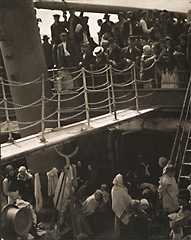Curriculum Materials: Art in America
|
|
Image 17 Alfred Stieglitz Questions: |
Think Questions
1. What do you think attracted Stieglitz most to this scene? What about the photograph attracts you the most?
2. Imagine that the man in the round white hat on the upper deck was not there. How would his absence change the picture? How would the picture be different if he had lifted his head up so that his hat could not be seen? Why do you think it was so important to Stieglitz that the straw hat remained in this position?
3. Why might Stieglitz have wanted to emphasize the group rather than individuals in this photograph?
4. Do you think these people knew their picture was being taken? If you were in their situation, would you want your picture taken? Why or why not?
5. By the early 1900s Stieglitz was making STRAIGHT PHOTOGRAPHS - photographs that are exposed and printed without special techniques that alter their appearance. He wanted to capture his subjects as they appeared at the time he took the photographs. How would the impact of The Steerage be different if Stieglitz had added color to it? If he had made it look more foggy? If he had printed the whole photo much darker?
6. When Stieglitz was working, many Americans did not accept photography as an art form equal to painting or sculpture. Stieglitz insisted that it was. Do you consider The Steerage a work of art? Why or why not? Why aren't all photographs considered works of art? Do you think any photograph considered a work of art by its maker is automatically a work of art? Can a photograph taken for pleasure with no artistic intent be considered a work of art?
7. What does The Steerage tell about the people represented in it? Stieglitz photographed these immigrants in the lower (steerage) level of a fashionable ship on a trip from the United States to Europe. Why would immigrants be on a boat headed to Europe?
8. Compare the arrangements of light and dark in Alfred Stieglitz's photograph with those in George Morrison's Collage IX: Landscape. How are light and dark used similarly? How does each artist use repeated shapes in his COMPOSITION? Do they use any of the same related shapes? Which ones? Why do you think each artist chose his MEDIUM? What are the advantages of each medium for creating a composition that focuses on light and dark contrasts and shapes?
|
|
